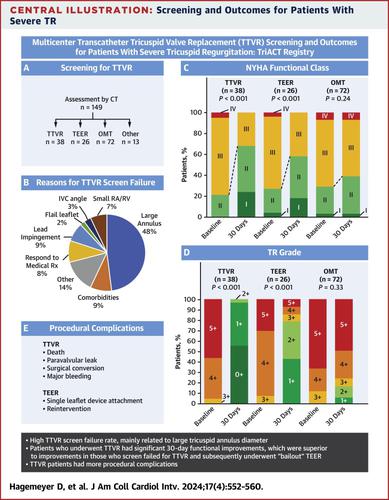当前位置:
X-MOL 学术
›
JACC Cardiovasc. Inte.
›
论文详情
Our official English website, www.x-mol.net, welcomes your feedback! (Note: you will need to create a separate account there.)
Clinical Characteristics and Outcomes of Patients Screened for Transcatheter Tricuspid Valve Replacement: The TriACT Registry
JACC: Cardiovascular Interventions ( IF 11.3 ) Pub Date : 2024-02-26 , DOI: 10.1016/j.jcin.2023.12.016 Daniel Hagemeyer , Anas Merdad , Laura Villegas Sierra , Andrea Ruberti , Faraj Kargoli , Marine Bouchat , Mauro Boiago , Aris Moschovitis , Djeven P. Deva , Lukas Stolz , Geraldine Ong , Mark D. Peterson , Nicolo Piazza , Maurizio Taramasso , Nicolas Dumonteil , Thomas Modine , Azeem Latib , Fabien Praz , Jörg Hausleiter , Neil P. Fam
JACC: Cardiovascular Interventions ( IF 11.3 ) Pub Date : 2024-02-26 , DOI: 10.1016/j.jcin.2023.12.016 Daniel Hagemeyer , Anas Merdad , Laura Villegas Sierra , Andrea Ruberti , Faraj Kargoli , Marine Bouchat , Mauro Boiago , Aris Moschovitis , Djeven P. Deva , Lukas Stolz , Geraldine Ong , Mark D. Peterson , Nicolo Piazza , Maurizio Taramasso , Nicolas Dumonteil , Thomas Modine , Azeem Latib , Fabien Praz , Jörg Hausleiter , Neil P. Fam

|
Transcatheter tricuspid valve replacement (TTVR) abolishes tricuspid regurgitation (TR) and has emerged as a definitive treatment for TR. The purpose of this multicenter, observational study was to determine the clinical characteristics and short-term outcomes of patients with TR screened for TTVR. Patients underwent TTVR screening at 7 centers on a compassionate-use basis. The primary endpoints were NYHA functional class and TR grade at 30-day follow-up. Secondary endpoints included all-cause mortality, heart failure hospitalization, technical success, and reasons for TTVR screening failure. A total of 149 patients (median age 79 years [Q1-Q3: 72-84 years], 54% women) underwent TTVR screening. The TTVR screening failure rate was 74%, mainly related to large tricuspid annular diameter. Patients undergoing TTVR (n = 38) had significant functional improvements (NYHA functional class I or II from 21% to 68%; < 0.001), with TR ≤1+ in 97% at 30-day follow-up ( < 0.001 from baseline). Technical success was achieved in 91%, with no intraprocedural mortality or conversion to surgery. At 30-day follow-up, mortality was 8%, heart failure hospitalization 5%, major bleeding 18%, and reintervention 9%. Patients who failed screening for TTVR and subsequently underwent “bailout” transcatheter edge-to-edge repair (n = 26) had favorable outcomes (NYHA functional class I or II from 27% to 58%; < 0.001), with TR ≤1+ in 43% at 30-day follow-up ( < 0.001 from baseline). This first real-world report of TTVR screening demonstrated a high screening failure rate, mainly related to large tricuspid annular diameter. Patients undergoing TTVR had superior TR reduction and symptom alleviation compared with bailout tricuspid transcatheter edge-to-edge repair, at the cost of greater procedural complications.
中文翻译:

经导管三尖瓣置换术筛查患者的临床特征和结果:TriACT 登记处
经导管三尖瓣置换术 (TTVR) 可消除三尖瓣反流 (TR),并已成为 TR 的明确治疗方法。这项多中心观察性研究的目的是确定接受 TTVR 筛查的 TR 患者的临床特征和短期结果。患者在 7 个中心以同情使用为基础接受了 TTVR 筛查。主要终点是 30 天随访时的 NYHA 功能等级和 TR 等级。次要终点包括全因死亡率、心力衰竭住院、技术成功以及 TTVR 筛查失败的原因。共有 149 名患者(中位年龄 79 岁 [Q1-Q3:72-84 岁],54% 为女性)接受了 TTVR 筛查。 TTVR筛查失败率为74%,主要与三尖瓣环直径过大有关。接受 TTVR 的患者 (n = 38) 具有显着的功能改善(NYHA 功能等级 I 或 II 从 21% 升至 68%;< 0.001),在 30 天的随访中,97% 的患者 TR ≤1+(与基线相比 < 0.001) )。 91% 的技术成功率很高,没有出现术中死亡或转为手术的情况。 30 天随访时,死亡率为 8%,心力衰竭住院率为 5%,大出血率为 18%,再干预率为 9%。 TTVR 筛查失败并随后接受“救助”经导管边对边修复术的患者 (n = 26) 获得了良好的结果(NYHA 功能分级 I 或 II 从 27% 降至 58%;< 0.001),TR ≤1+ 30 天随访时,率为 43%(与基线相比 < 0.001)。这是第一份真实世界的 TTVR 筛查报告,显示筛查失败率很高,主要与三尖瓣环直径较大有关。与救助性三尖瓣经导管边对边修复术相比,接受 TTVR 的患者具有更好的 TR 减少和症状缓解效果,但代价是更大的手术并发症。
更新日期:2024-02-26
中文翻译:

经导管三尖瓣置换术筛查患者的临床特征和结果:TriACT 登记处
经导管三尖瓣置换术 (TTVR) 可消除三尖瓣反流 (TR),并已成为 TR 的明确治疗方法。这项多中心观察性研究的目的是确定接受 TTVR 筛查的 TR 患者的临床特征和短期结果。患者在 7 个中心以同情使用为基础接受了 TTVR 筛查。主要终点是 30 天随访时的 NYHA 功能等级和 TR 等级。次要终点包括全因死亡率、心力衰竭住院、技术成功以及 TTVR 筛查失败的原因。共有 149 名患者(中位年龄 79 岁 [Q1-Q3:72-84 岁],54% 为女性)接受了 TTVR 筛查。 TTVR筛查失败率为74%,主要与三尖瓣环直径过大有关。接受 TTVR 的患者 (n = 38) 具有显着的功能改善(NYHA 功能等级 I 或 II 从 21% 升至 68%;< 0.001),在 30 天的随访中,97% 的患者 TR ≤1+(与基线相比 < 0.001) )。 91% 的技术成功率很高,没有出现术中死亡或转为手术的情况。 30 天随访时,死亡率为 8%,心力衰竭住院率为 5%,大出血率为 18%,再干预率为 9%。 TTVR 筛查失败并随后接受“救助”经导管边对边修复术的患者 (n = 26) 获得了良好的结果(NYHA 功能分级 I 或 II 从 27% 降至 58%;< 0.001),TR ≤1+ 30 天随访时,率为 43%(与基线相比 < 0.001)。这是第一份真实世界的 TTVR 筛查报告,显示筛查失败率很高,主要与三尖瓣环直径较大有关。与救助性三尖瓣经导管边对边修复术相比,接受 TTVR 的患者具有更好的 TR 减少和症状缓解效果,但代价是更大的手术并发症。



























 京公网安备 11010802027423号
京公网安备 11010802027423号